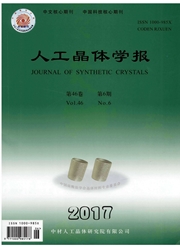

 中文摘要:
中文摘要:
分别采用非水解和水解溶胶-凝胶法制备TiO2薄膜,利用FTIR、TG-DSC和XRD等手段研究了薄膜形成过程中的溶胶-凝胶转变过程和相变化过程,并探讨了非水解和水解溶胶-凝胶法的微观反应机制。研究表明:非水解溶胶-凝胶法与水解溶胶-凝胶法制备TiO2薄膜的微观反应机制不同,水解溶胶-凝胶法是钛酸丁酯的Ti-O键合(Ti-OR)断裂形成水解产物Ti-OH,再经失水缩聚或是失醇缩聚反应形成Ti-O-Ti键合。而非水解溶胶-凝胶法是在不生成Ti-OH的情况下,利用Ti-Cl与Ti-OR通过亲核反应直接缩聚反应产生Ti-O-Ti键合。非水解溶胶-凝胶法制备的TiO2薄膜开始出现金红石相的温度为750℃,明显高于水解溶胶-凝胶法制备的TiO2薄膜。
 英文摘要:
英文摘要:
TiO2 film was prepared by non-hydrolytic and hydrolytic sol-gel method,respectively.The sol-gel process,the phase transformation and the reaction mechanism of TiO2 film were studied by FTIR,TG-DSC and XRD analysis.The results show that the reaction mechanism of the preparation of TiO2 film by non-hydrolytic and hydrolytic sol-gel method is different.During the hydrolytic sol-gel process,the Ti-OR bond in the tetrabutyl titanate cleavages into Ti-OH bond,which react with Ti-OH or Ti-OR to form Ti-O-Ti.The non-hydrolytic route involves the Ti-Cl react with Ti-OR by a nuclear reaction to form Ti-O-Ti bond,on the condition of not forming Ti-OH bond.The phase transition temperature of anatase-to-rutile by non-hydrolytic sol-gel is 750 ℃,which is higher than that by hydrolytic sol-gel methods.
 同期刊论文项目
同期刊论文项目
 同项目期刊论文
同项目期刊论文
 期刊信息
期刊信息
